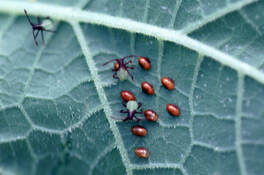
Adult squash bugs are greyish-brown and have wings that lay flat over the back. They have orange-brown stripes on the underside of the body. Nymphs are small and greenish with black legs but turn greyish-brown as they develop. Nymphs do not have wings but wing development may be noticeable as they age.
Unmated adults overwinter in plant debris. From late April through May the adults emerge, mate and find a host plant. Female adults lay clusters of brownish-red eggs over several weeks on the underside of leaves. Within two weeks the eggs hatch and nymphs begin to feed on their host plant. Nymphs reach maturity in 4 to 6 weeks when they mate and begin a second generation during the same growing season. Adults from this generation will overwinter to lay eggs the following year.
The hard body of the adult squash bug is difficult to penetrate making control during the nymph stage essential. Regularly monitor plants for signs of squash bugs. Remove plant debris to disrupt overwintering habitats. General use insecticides such as permethrin (Bug-B-Gon Multi-Purpose Garden Dust; Green Thumb Multipurpose Garden and Pet Dust; Bug-No-More Yard and Garden Insect Spray; Eight Vegetable, Fruit and Flower Concentrate; Garden and Farm Insect Control; Lawn & Garden Insect Killer), malathion, and methoxychlor provide control if a direct application is made to young, soft-bodied squash bugs. Contact with the nymphs is required for control so be sure to spray the undersides of the leaves. (Cynthia Domenghini)
 RSS Feed
RSS Feed
